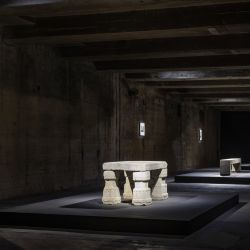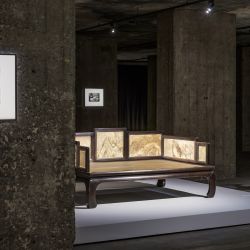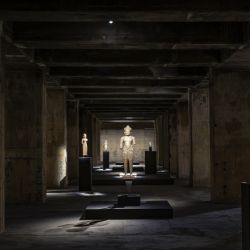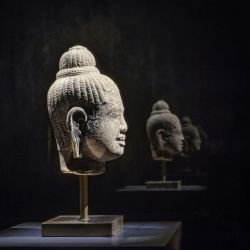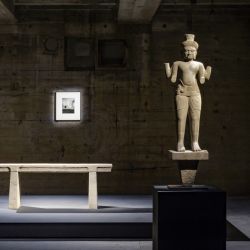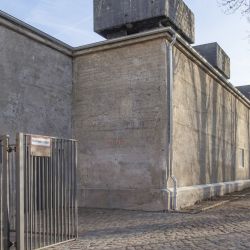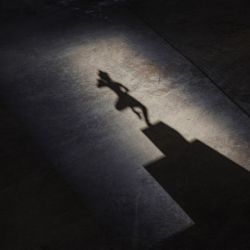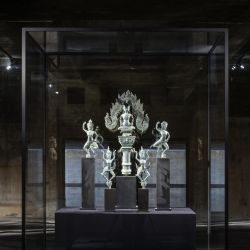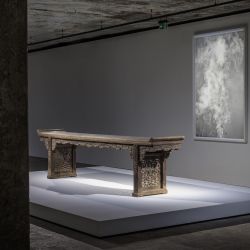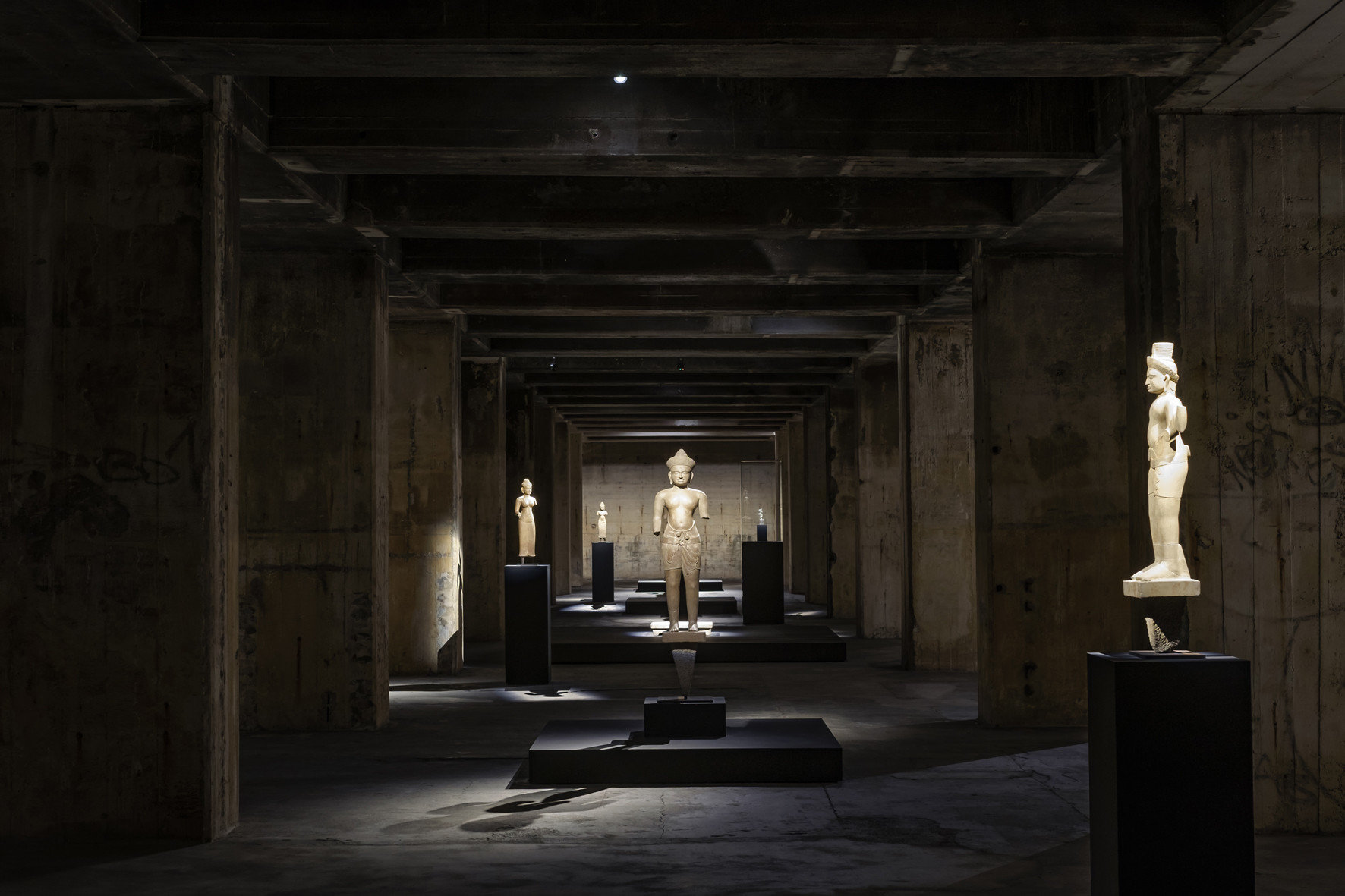
Download this article:
The effective game of opposites: focused light in absolute darkness lets you forget space and time. A visit to the Feuerle Collection in Berlin is an unforgettable experience for all art lovers. This is due to the exquisite, as well as unconventional, character of this collection, its special presentation location and its highly effective staging. Light plays a major role in this.
Berlin has an extensive series of important private art collections that are open to the interested public. The Feuerle Collection, opened in Kreuzberg in 2016, stands out from this illustrious circle in many respects. This is mainly due to the unique design of the collection. Désiré Feuerle, a discreet and influential personality on the international art scene, combines works by renowned contemporary artists - such as Anish Kapoor, Zeng Fanzhi, Cristina Iglesias and Nobuyoshi Araki - with sculptures of Khmer culture from the 7th to the 13th centuries as well as furniture from the Chinese imperial court created between 200 BC and the early 17th century (from the Han to the Qing Dynasty).
Feuerle the aim of the compilation and presentation of his collection was to promote dialogue between different epochs and cultures and thus open up new perspectives regarding the carefully selected works. And in fact, this often surprising juxtaposition of artifacts created in very diverse contexts is indeed highly appealing and stimulating. It offers not only aesthetic pleasure but also intellectual pleasure - consciously beyond classical art-historical approaches.
A converted bunker
One of the special features of the Feuerle Collection is its location: at the edge of the Anhalter railway station area there is a bunker which has been unused for decades. It was built shortly before the end of the Second World War for the telecommunications network of the Deutsche Reichsbahn. For its new use as a museum, the building has been renovated and converted by none other than the British star architect John Pawson. Known as an art-loving and minimalist designer, Pawson set to work on this task with extreme restraint. From the first site visit, he relates, it had become clear to him that he wanted to "change as little as possible" in the existing building. In addition to the mandatory measures which were mainly of a technical nature, he therefore concentrated on "a series of subtle refinements and interventions that intensify the quality of the space". He benefited from the internal structure of the former telecommunications bunker which essentially consists of two large, hall-like rooms. On the outside, the building located directly on the Landwehr Canal looks almost unchanged. Only discreet lettering next to the entrance hints at its new use.
Effective staging
Those who visit the bunker - by prior appointment - will be escorted into the basement One enters a room in which seemingly complete darkness reigns. The minutes in the dark, accompanied by minimalist music by the American composer John Cage, serve a dual purpose: the almost meditative entrance ceremony, in which one leaves the noisy, stimulus-flooded everyday life behind, opens the senses and mentally prepares the audience for the subsequent exhibition. The eyes gradually become accustomed to the darkness and a faint glow of light begins to appear on one side of the room. Following this, visitors enter the first dimly illuminated room. The gaze initially falls on a series of stone Khmer figures that seem to float in space. From now on, concentrated light, aligned with extreme precision, guides the visitor on their tour of discovery through space, emphasising the three-dimensional contours of the sculptures, focusing on fine details and supporting a holistic view of the objects, as intended by the collector. Feuerle, merely by the means of light and light guidance, achieves an extremely effective and at the same time discreet presentation which leaves a strong impression. In an almost textbook manner, it demonstrates how light directs the gaze and stimulates the visual attention of the visitor. It also soon becomes clear to visitors why an old bunker offers the ideal spatial setting for this collection and this type of presentation.
ERCO - not only from experience
Désiré Feuerle, who worked as a gallery owner in Cologne in the 1990s, worked exclusively during this time with artificial light in his exhibitions using ERCO lighting tools. It thus also makes sense that he should use products from the Lüdenscheid light factory for the presentation of his collection in Berlin. A collector like Feuerle however, who never compromises on quality, does not rely solely on the good reputation of a brand and previous experience. The decision in favour of ERCO was made only after extensive sampling, careful selection of the luminaires and an intensive test phase. 
The Feuerle Collection was equipped exclusively with luminaires from the Pollux product family featuring LED modules with wattages of 2W or 6W. Spotlights with narrow spot, spot or flood light distribution are used in accordance with the exhibit size, distance from the light source and light requirement. Contour spotlights precisely illuminate the two-dimensional works of art, which seem to shine from within themselves, and floodlights with oval flood light distribution provide uniform illumination of the larger exhibition objects. Due to the overall low levels of brightness in the exhibition rooms being concentrated on a few points, the technical lighting installation largely recedes into the background. The black track, spotlights and floodlights can hardly be seen. The compact dimensions of the Pollux spotlights is all that is needed to make the lighting infrastructure seem to almost disappear. Nothing should distract from the enjoyment of the art.
Project data
Client: The Feuerle Collection
Architecture: John Pawson, London / Great Britain
Lighting design: Désiré Feuerle, Berlin / Germany
Photography: Sebastian Mayer, Berlin / Germany
Product: Pollux
Photo credits: © ERCO GmbH, www.erco.com, photography: Sebastian Mayer
About ERCO
The ERCO Light Factory in Lüdenscheid is a leading international specialist in architectural lighting using LED technology. The family business, founded in 1934, now operates as a global player with over 60 subsidiaries, branches and agencies in over 40 countries worldwide. Since 2015 ERCO's portfolio has been 100% LED. Inspired by "light digital" as its leitmotif, ERCO in Lüdenscheid develops, designs and produces digital luminaires with focus on photometrics, electronics and design. Working closely with architects, lighting designers and engineers, ERCO develops lighting tools used primarily for applications in the following fields: Work, Shop, Culture, Community, Hospitality, Living, Public and Contemplation. ERCO understands digital light as the fourth dimension of architecture - providing highly precise and efficient lighting solutions to support creative designers in turning their visions into reality.
If you require any further information on ERCO or image material, please visit us at www.erco.com/presse. We can also provide you with material on projects worldwide for your media coverage.
Relevant image material
© ERCO GmbH, www.erco.com
© ERCO GmbH, www.erco.com
© ERCO GmbH, www.erco.com
© ERCO GmbH, www.erco.com
© ERCO GmbH, www.erco.com
© ERCO GmbH, www.erco.com
© ERCO GmbH, www.erco.com
© ERCO GmbH, www.erco.com
© ERCO GmbH, www.erco.com
